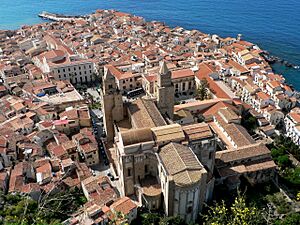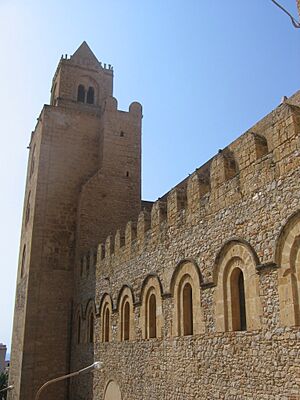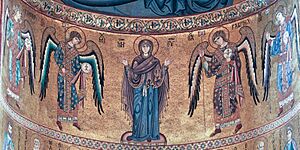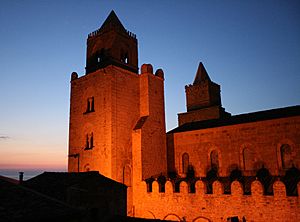Cefalù Cathedral facts for kids
Quick facts for kids Cathedral-Basilica of CefalùDuomo di Cefalù |
|
|---|---|
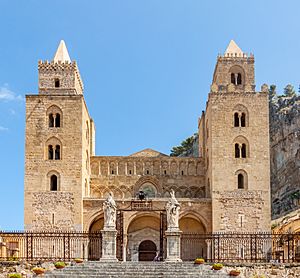
The façade of the cathedral
|
|
| Religion | |
| Affiliation | Roman Catholic Church |
| Province | Diocese of Cefalù |
| Ecclesiastical or organizational status | Cathedral |
| Year consecrated | 1267 |
| Status | Active |
| Location | |
| Location | Cefalù, Italy |
| Architecture | |
| Architectural type | Church |
| Architectural style | Norman-Arab-Byzantine |
| Groundbreaking | 1131 |
| Completed | 1240 |
| Official name: Arab-Norman Palermo and the Cathedral Churches of Cefalù and Monreale | |
| Type | Cultural |
| Criteria | ii, iv |
| Designated | 2015 (39th session) |
| Reference no. | 1487-008 |
| State Party | |
| Region | Europe and North America |
The Cathedral of Cefalù (also called Duomo di Cefalù in Italian) is a beautiful Roman Catholic church in Cefalù, Sicily. It's a very important building. In fact, it is one of nine special places that are part of a UNESCO World Heritage Site. This site is called Arab-Norman Palermo and the Cathedral Churches of Cefalù and Monreale.
The cathedral was built between 1131 and 1240. It shows the Norman style. The Normans had taken over Sicily in 1091. People say that King Roger II promised to build this church. He made the promise after he survived a big storm and landed safely on Cefalù's beach. The building looks a bit like a fortress. From far away, it stands out against the town's skyline. It was a strong symbol of the Normans' power.
Contents
A Look at Its History
The cathedral was built in an area that had been lived in for a long time. There was even an old Roman road and an early Christian mosaic found there. Building started in 1131. The beautiful mosaics in the apse (the rounded end of the church) began in 1145. King Roger II also had special stone coffins (sarcophagi) placed there for himself and his wife that same year.
After 1172, the church faced some tough times. In 1215, Frederick II of Hohenstaufen moved the two sarcophagi to the Cathedral of Palermo. But construction on the Cefalù Cathedral started again soon after. The front part of the church was finished in 1240. The cathedral was officially blessed and opened in 1267 by Rodolphe de Chevrières, a bishop.
Later, in 1472, a portico (a covered walkway) was added to the front. It was designed by Ambrogio da Como.
Exploring the Cathedral's Design
How the Cathedral Was Built
In front of the cathedral, there is a large, flat area called a parvis. This space used to be a cemetery. People believed the earth there came from Jerusalem. They thought this special earth would help bodies turn into mummies quickly.
The front of the cathedral has two big Norman towers. These towers have mullioned windows, which means they have vertical stone bars dividing them. On top of each tower is a small spire, added in the 1400s. Each spire is different. One is square with flame-shaped merlons (the solid parts of a castle wall). These symbolize the Pope's power. The other spire is octagonal with Ghibelline merlons, which represent the king's power.
The 15th-century portico at the front has three arches. The two outer arches are pointed. They are held up by four columns. Under this portico is the Porta Regum, or "Kings' Door." It has a beautifully decorated marble entrance with paintings on the walls next to it.
Inside, the cathedral is shaped like a Latin cross. It has a main area called a nave and two side areas called aisles. These are separated by rows of old columns. There are fourteen columns made of pink granite and two made of cipolin (a type of marble). Their bases and tops (capitals) are from the 2nd century AD. Two large capitals that support the main arch of the nave were likely made in Sicily around the mid-1100s.
The roof of the nave was made lower at some point. You can see this from the outside. The transept (the part that crosses the main body of the church) is taller than the nave and aisles. Some parts of the building have rounded ceilings (barrel-vaulted). Other parts have open wooden roofs. The presbytery, which is the area around the altar, has a stone ceiling with ribs.
Beyond the crossing, the church mixes two styles. It has the strong, simple shapes of Romanesque buildings. But it also uses the pointed arch, which is a feature of Gothic style. This mix is also seen in Monreale Cathedral. It was an early example of the Gothic style that would become popular in Paris a few years later.
The church has three apses, which are rounded ends. This design is also found at Monreale Cathedral in Sicily. The two smaller side apses have decorations on their upper outside parts. These include blind arcading (arches that are just for decoration) and sculpted corbels (stone supports sticking out from the wall). These corbels, from 1215 to 1223, show masks, animal heads, and twisted human figures. The corbels on the main apse are newer. The central apse originally had three large round windows. These were later covered to make space for the mosaic. It also had a larger, pointed central window. Two other pairs of round windows are at the ends of the transept.
The Cathedral's Cloister
The cathedral also has a cloister, which is a peaceful courtyard with covered walkways. You can enter it from inside the church. The walkways have pointed arches, each resting on thin, paired columns. This design is similar to cloisters in Spain and France. The tops of the columns (capitals) have Norman and other Romanesque designs. This cloister became a model for other Norman cloisters built later in Sicily, especially the one at Monreale.
Amazing Art Inside
The Presbyterium Mosaic
It was probably planned for the whole church to be covered in mosaics. But only the presbyterium area was completed. Mosaics still cover the apse and about half of the side walls there. King Roger II brought skilled mosaic artists from Constantinople. They used their traditional Byzantine art style but adapted it to the church's northern European design.
The most important figure in the mosaics is the bust of Christ Pantokrator. He is shown in the half-dome of the apse with one hand raised in a blessing. In his left hand, he holds the Gospel of John. You can read words in Greek and Latin: "I am the light of the world, who follows me will not wander in the darkness but will have the light of life" (John, 8:12).
Above Christ, on the apse wall, is a mosaic of the Blessed Virgin Mary. Her hands are raised in prayer. She is flanked by four archangels. In the rows below, on either side of the central window, are figures of apostles and evangelists. Their placement was carefully planned to tell a religious story.
The mosaic art continues into the presbyterium. The side walls show figures of prophets and saints. On the right wall, near where the king's throne would be, are royal figures. On the left side, near the bishop's throne, are figures of priests. Each figure has a name written next to it in Greek or Latin. The ceiling of this area shows four cherubim and four seraphim.
The main figures, Christ Pantokrator and the Virgin Mary, wear blue clothes. They glow against a background of gold tiles. This artwork is of the highest quality. It shows great skill in how the clothes drape and how the faces and hand gestures are shown. It is thought to be the best Byzantine mosaic in Italy. It is as good as other famous Byzantine art from Constantinople.
The Byzantine mosaic work was finished before 1170. The lower parts and side walls of the presbyterium were not completed until the 1600s. They covered older paintings, but only small traces of those remain today.
Other Artworks to See
Some of the original paintings still exist. There is a figure of Urban V from the late 1300s on a column in the left aisle. Also, a "Madonna enthroned" from the 1400s is in the left arm of the transept.
The church also has several old tombs. These include an ancient sarcophagus, a medieval one, and the important tomb of Bishop Castelli from the 1700s.
The baptismal font, used for baptisms, is from the 1100s. It was carved from a single stone block and has four small sculpted lions. The church also has a painting of the Madonna from Antonello Gagini's workshop (1500s). There is also a painted wooden cross by Guglielmo da Pesaro (1468). The organ is a large instrument with two keyboards and plain pipes. It sits above a wooden case.
The ceiling of the nave has painted decorations. These show busts, imaginary animals, and other designs. These were probably made by Arabic artists.
Since 1985, an artist from Palermo named Michele Canzoneri has added 72 modern, abstract, stained-glass windows. These windows show stories from the Old and New Testaments. Their modern style has caused some discussion.
Ancient Mosaics
When people dug around the cathedral, they found parts of a colorful mosaic from the 500s. It shows a dove drinking, parts of two other birds, two small trees, and a lily-shaped flower. All of this is inside a frame with pointed and diamond shapes.
This mosaic likely belonged to an older Byzantine church that was there before. This area of Cefalù was used a lot, at least until the 700s. At that time, it was a place where a bishop lived.
See also
 In Spanish: Catedral de Cefalú para niños
In Spanish: Catedral de Cefalú para niños
- Cathedral of Monreale
- Palazzo dei Normanni
- Arab-Norman Palermo and the Cathedral Churches of Cefalù and Monreale


